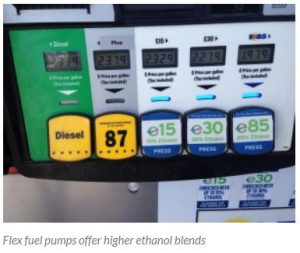Despite over 98% of all gasoline sold in the United States containing ethanol, over 80% of consumers do not know how much ethanol is present in their gasoline, or what the additional ethanol gasoline means. In this brief overview, we will uncover who can use it, where to find it, and what are some of the benefits of a higher ethanol content.Conventional gasoline vs E10 or E15
Conventional gasoline is what most consumers equate with a non-ethanol grade of gasoline and was the standard for decades. For the longest time this was the only type of fuel available at most major retail pumps. In recent decades, there has been a push for reduced emissions and cheaper gasoline prices, hence the introduction of E10 and E15. The ‘E10’ or ‘E15’ specifier is indicating the percentage of ethanol content within the fuel that most use today and buying at local fuel pumps. An example of an ethanol rating we have all noticed recently is the special dispensers for E85 fuel, which contains up to 85% Ethanol.
How do I know if I am buying E10 or E15?
The Regular, Mid-Grade, and Premium labels you notice at the pumps are for the E10 products. E15 can be marketed in many ways, such as E15, 88-Octane, or even Unleaded-15. The best way to notice if E15 is available at your local pump, is by noticing a different colored dispenser for each pump. This is in part to call special attention to ensure the consumer is selecting the proper dispenser for their needs and not blindly selecting a dispenser hose that looks just like the one they “always use”.
What benefits do I get from E15?
Ethanol can be attributed to a boost in octane, and a cleaner burning fuel source. Octane enhancement helps vehicle performance by reducing potential for “knocking”, which is something that can create catastrophic failure to an engine. It is also a cooler temperature burn and a more oxygen rich burn, which helps reduce vehicle emissions. A more oxygen rich fuel encourages a more complete combustion, which puts less stress on catalytic converters to burn off any product not completely combusted within the engine. Catalytic converters are some of the costliest items to repair on a passenger vehicle due the special metals utilized to encourage proper emissions. Your wallet will also thank you for using the increased ethanol content as it encourages less expensive pump prices.
https://www.cspdailynews.com/fuels/3-explanations-will-reduce-customer-confusion-about-e15
https://www1.eere.energy.gov/vehiclesandfuels/pdfs/basics/jtb_ethanol.pdf
https://ethanol.nebraska.gov/tag/flex-fuel-pumps/



